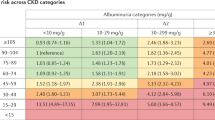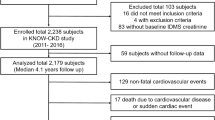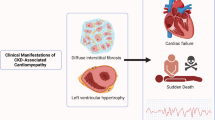Abstract
Patients with chronic kidney disease (CKD) have a reduced lifespan, and a substantial proportion of these individuals die from cardiovascular disease. Although a large percentage of patients with CKD have traditional cardiac risk factors such as diabetes, hypertension and abnormalities in cholesterol, interventions to address these factors—which have significantly decreased cardiovascular mortality in the general population—have not shown such benefit in the CKD population. In addition, the severity and extent of cardiovascular complications in patients with CKD is disproportionate to the number and severity of traditional risk factors. This realization has focused attention on nontraditional cardiac risk factors that are particularly relevant to patients with CKD, including decreased hemoglobin levels, microalbuminuria, increased inflammation and oxidative stress, and abnormalities in bone and mineral metabolism. However, large prospective trials in patients with advanced CKD or in those requiring chronic dialysis have not shown that normalization of these nontraditional risk factors improves survival. Moreover, the mechanisms by which these nontraditional risk factors contribute to cardiovascular disease are unknown. Therefore, although current treatment of patients with CKD includes management of traditional and nontraditional risk factors, the value of modifying some nontraditional risk factors remains unclear.
Key Points
-
Patients with chronic kidney disease (CKD) have a very high risk of cardiovascular events and death
-
Patients with CKD have a high prevalence of traditional and nontraditional cardiac risk factors
-
Nontraditional cardiac risk factors, including anemia, inflammation, oxidative stress and hyperphosphatemia, are associated with cardiovascular disease in patients with CKD
-
The mechanisms by which these nontraditional risk factors contribute to cardiovascular disease in CKD are not well understood
-
Treatment of CKD includes management of traditional and nontraditional cardiovascular risk factors, but the value of modifying some nontraditional risk factors remains unclear
This is a preview of subscription content, access via your institution
Access options
Subscribe to this journal
Receive 12 print issues and online access
$209.00 per year
only $17.42 per issue
Buy this article
- Purchase on Springer Link
- Instant access to full article PDF
Prices may be subject to local taxes which are calculated during checkout
Similar content being viewed by others
References
Coresh J et al. (2003) Prevalence of chronic kidney disease and decreased kidney function in the adult US population: Third National Health and Nutrition Examination Survey. Am J Kidney Dis 41: 1–12
Xue JL et al. (2001) Forecast of the number of patients with end-stage renal disease in the United States to the year 2010. J Am Soc Nephrol 12: 2753–2758
Coresh J et al. (2007) Prevalence of chronic kidney disease in the United States. JAMA 298: 2038–2047
Keith DS et al. (2004) Longitudinal follow-up and outcomes among a population with chronic kidney disease in a large managed care organization. Arch Intern Med 164: 659–663
Cheung AK et al. (2004) Cardiac diseases in maintenance hemodialysis patients: results of the HEMO Study. Kidney Int 65: 2380–2389
Go AS et al. (2004) Chronic kidney disease and the risks of death, cardiovascular events, and hospitalization. N Engl J Med 351: 1296–1305
Stenvinkel P et al. (2003) Coronary artery disease in end-stage renal disease: no longer a simple plumbing problem. J Am Soc Nephrol 14: 1927–1939
Kannel WB et al. (1961) Factors of risk in the development of coronary heart disease–six year follow-up experience: the Framingham Study. Ann Intern Med 55: 33–50
Vlagopoulos PT and Sarnak MJ (2005) Traditional and nontraditional cardiovascular risk factors in chronic kidney disease. Med Clin North Am 89: 587–611
Reis SE et al. (2002) Mild renal insufficiency is associated with angiographic coronary artery disease in women. Circulation 105: 2826–2829
Parfrey PS and Foley RN (1999) The clinical epidemiology of cardiac disease in chronic renal failure. J Am Soc Nephrol 10: 1606–1615
Weiner DE et al. (2008) The relationship between nontraditional risk factors and outcomes in individuals with stage 3 to 4 CKD. Am J Kidney Dis 51: 212–223
Shlipak MG et al. (2004) Chronic renal insufficiency and cardiovascular events in the elderly: findings from the Cardiovascular Health Study. Am J Geriatr Cardiol 13: 81–90
Ritz E and McClellan WM (2004) Overview: increased cardiovascular risk in patients with minor renal dysfunction: an emerging issue with far-reaching consequences. J Am Soc Nephrol 15: 513–516
Appel LJ (2004) Beyond (or back to) traditional risk factors: preventing cardiovascular disease in patients with chronic kidney disease. Ann Intern Med 140: 60–61
Agewall S et al. (1997) Usefulness of microalbuminuria in predicting cardiovascular mortality in treated hypertensive men with and without diabetes mellitus: Risk Factor Intervention Study Group. Am J Cardiol 80: 164–169
Dinneen SF and Gerstein HC (1997) The association of microalbuminuria and mortality in non-insulin-dependent diabetes mellitus: a systematic overview of the literature. Arch Intern Med 157: 1413–1418
Gerstein HC et al. (2001) Albuminuria and risk of cardiovascular events, death, and heart failure in diabetic and nondiabetic individuals. JAMA 286: 421–426
Wachtell K et al. (2003) Albuminuria and cardiovascular risk in hypertensive patients with left ventricular hypertrophy: the LIFE study. Ann Intern Med 139: 901–906
Pedrinelli R et al. (2004) Low-grade inflammation and microalbuminuria in hypertension. Arterioscler Thromb Vasc Biol 24: 2414–2419
Clausen P et al. (2001) Elevated urinary albumin excretion is associated with impaired arterial dilatory capacity in clinically healthy subjects. Circulation 103: 1869–1874
Pedrinelli R et al. (1994) Microalbuminuria and endothelial dysfunction in essential hypertension. Lancet 344: 14–18
Persson F et al. (2008) Endothelial dysfunction and inflammation predict development of diabetic nephropathy in the Irbesartan in Patients with Type 2 Diabetes and Microalbuminuria (IRMA 2) study. Scand J Clin Lab Invest [10.1080/00365510802187226]
Cottone S et al. (2007) Microalbuminuria and early endothelial activation in essential hypertension. J Hum Hypertens 21: 167–172
Dell'Omo G et al. (2007) Lack of association between endothelial nitric oxide synthase gene polymorphisms, microalbuminuria, and endothelial dysfunction in hypertensive men. J Hypertens 25: 1389–1395
Bianchi S et al. (1999) Microalbuminuria in essential hypertension: significance, pathophysiology, and therapeutic implications. Am J Kidney Dis 34: 973–995
Freedman BI et al. (2005) Relationship between albuminuria and cardiovascular disease in type 2 diabetes. J Am Soc Nephrol 16: 2156–2161
Barzilay JI et al. (2004) The relationship of cardiovascular risk factors to microalbuminuria in older adults with or without diabetes mellitus or hypertension: the Cardiovascular Health Study. Am J Kidney Dis 44: 25–34
Asselbergs FW et al. (2004) Effects of fosinopril and pravastatin on cardiovascular events in subjects with microalbuminuria. Circulation 110: 2809–2816
The Heart Outcomes Prevention Evaluation Study Investigators (2000) Effects of an angiotensin-converting-enzyme inhibitor, ramipril, on cardiovascular events in high-risk patients. N Engl J Med 342: 145–153
Kazmi WH et al. (2001) Anemia: an early complication of chronic renal insufficiency. Am J Kidney Dis 38: 803–812
Levin A et al. (1999) Left ventricular mass index increase in early renal disease: impact of decline in hemoglobin. Am J Kidney Dis 34: 125–134
Jurkovitz CT et al. (2003) Association of high serum creatinine and anemia increases the risk of coronary events: results from the prospective community-based atherosclerosis risk in communities (ARIC) study. J Am Soc Nephrol 14: 2919–2925
Sarnak MJ et al. (2002) Anemia as a risk factor for cardiovascular disease in the Atherosclerosis Risk in Communities (ARIC) study. J Am Coll Cardiol 40: 27–33
Foley RN et al. (1996) The impact of anemia on cardiomyopathy, morbidity, and and mortality in end-stage renal disease. Am J Kidney Dis 28: 53–61
Levin A et al. (1996) Prevalent left ventricular hypertrophy in the predialysis population: identifying opportunities for intervention. Am J Kidney Dis 27: 347–354
Weiner DE et al. (2005) Effects of anemia and left ventricular hypertrophy on cardiovascular disease in patients with chronic kidney disease. J Am Soc Nephrol 16: 1803–1810
Besarab A et al. (1998) The effects of normal as compared with low hematocrit values in patients with cardiac disease who are receiving hemodialysis and epoetin. N Engl J Med 339: 584–590
Singh AK et al. (2006) Correction of anemia with epoetin alfa in chronic kidney disease. N Engl J Med 355: 2085–2098
Drueke TB et al. (2006) Normalization of hemoglobin level in patients with chronic kidney disease and anemia. N Engl J Med 355: 2071–2084
Roger SD et al. (2004) Effects of early and late intervention with epoetin alpha on left ventricular mass among patients with chronic kidney disease (stage 3 or 4): results of a randomized clinical trial. J Am Soc Nephrol 15: 148–156
Ritz E et al. (2007) Target level for hemoglobin correction in patients with diabetes and CKD: primary results of the Anemia Correction in Diabetes (ACORD) Study. Am J Kidney Dis 49: 194–207
National Kidney Foundation (2002) K/DOQI clinical practice guidelines for chronic kidney disease: evaluation, classification, and stratification. Am J Kidney Dis 39: S1–S266
Rao M and Pereira BJ (2003) Prospective trials on anemia of chronic disease: the Trial to Reduce Cardiovascular Events with Aranesp Therapy (TREAT). Kidney Int Suppl 87: S12–S19
Diaz MN et al. (1997) Antioxidants and atherosclerotic heart disease. N Engl J Med 337: 408–416
Granger DN et al. (2004) Modulation of the inflammatory response in cardiovascular disease. Hypertension 43: 924–931
Ross R (1999) Atherosclerosis—an inflammatory disease. N Engl J Med 340: 115–126
Oberg BP et al. (2004) Increased prevalence of oxidant stress and inflammation in patients with moderate to severe chronic kidney disease. Kidney Int 65: 1009–1016
Shlipak MG et al. (2003) Elevations of inflammatory and procoagulant biomarkers in elderly persons with renal insufficiency. Circulation 107: 87–92
Cheung AK et al. (2000) Atherosclerotic cardiovascular disease risks in chronic hemodialysis patients. Kidney Int 58: 353–362
Zimmermann J et al. (1999) Inflammation enhances cardiovascular risk and mortality in hemodialysis patients. Kidney Int 55: 648–658
Yeun JY et al. (2000) C-reactive protein predicts all-cause and cardiovascular mortality in hemodialysis patients. Am J Kidney Dis 35: 469–476
Iseki K et al. (1999) Serum C-reactive protein (CRP) and risk of death in chronic dialysis patients. Nephrol Dial Transplant 14: 1956–1960
Wang AY et al. (2008) Increased circulating inflammatory proteins predict a worse prognosis with valvular calcification in end-stage renal disease: a prospective cohort study. Am J Nephrol 28: 647–653
Menon V et al. (2005) C-reactive protein and albumin as predictors of all-cause and cardiovascular mortality in chronic kidney disease. Kidney Int 68: 766–772
Friedman AN et al. (2005) C-reactive protein as a predictor of total arteriosclerotic outcomes in type 2 diabetic nephropathy. Kidney Int 68: 773–778
Shlipak MG et al. (2005) Cardiovascular mortality risk in chronic kidney disease: comparison of traditional and novel risk factors. JAMA 293: 1737–1745
Ravani P et al. (2005) Asymmetrical dimethylarginine predicts progression to dialysis and death in patients with chronic kidney disease: a competing risks modeling approach. J Am Soc Nephrol 16: 2449–2455
Fried LF et al. (2005) Kidney function as a predictor of noncardiovascular mortality. J Am Soc Nephrol 16: 3728–3735
Fliser D et al. (2005) Asymmetric dimethylarginine and progression of chronic kidney disease: the mild to moderate kidney disease study. J Am Soc Nephrol 16: 2456–2461
Valkonen VP et al. (2001) Risk of acute coronary events and serum concentration of asymmetrical dimethylarginine. Lancet 358: 2127–2128
Zoccali C et al. (2001) Plasma concentration of asymmetrical dimethylarginine and mortality in patients with end-stage renal disease: a prospective study. Lancet 358: 2113–2117
Drexler H et al. (1991) Correction of endothelial dysfunction in coronary microcirculation of hypercholesterolaemic patients by L-arginine. Lancet 338: 1546–1550
Lerman A et al. (1998) Long-term L-arginine supplementation improves small-vessel coronary endothelial function in humans. Circulation 97: 2123–2128
Boaz M et al. (2000) Secondary prevention with antioxidants of cardiovascular disease in endstage renal disease (SPACE): randomised placebo-controlled trial. Lancet 356: 1213–1218
Tepel M et al. (2003) The antioxidant acetylcysteine reduces cardiovascular events in patients with end-stage renal failure: a randomized, controlled trial. Circulation 107: 992–995
Arnadottir M et al. (1996) The effect of reduced glomerular filtration rate on plasma total homocysteine concentration. Scand J Clin Lab Invest 56: 41–46
Friedman AN et al. (2001) The kidney and homocysteine metabolism. J Am Soc Nephrol 12: 2181–2189
McCully KS (1969) Vascular pathology of homocysteinemia: implications for the pathogenesis of arteriosclerosis. Am J Pathol 56: 111–128
Hofmann MA et al. (2001) Hyperhomocysteinemia enhances vascular inflammation and accelerates atherosclerosis in a murine model. J Clin Invest 107: 675–683
Bostom AG et al. (1997) Elevated fasting total plasma homocysteine levels and cardiovascular disease outcomes in maintenance dialysis patients: a prospective study. Arterioscler Thromb Vasc Biol 17: 2554–2558
Jungers P et al. (1997) Hyperhomocysteinemia is associated with atherosclerotic occlusive arterial accidents in predialysis chronic renal failure patients. Miner Electrolyte Metab 23: 170–173
Bonaa KH et al. (2006) Homocysteine lowering and cardiovascular events after acute myocardial infarction. N Engl J Med 354: 1578–1588
Lonn E et al. (2006) Homocysteine lowering with folic acid and B vitamins in vascular disease. N Engl J Med 354: 1567–1577
Toole JF et al. (2004) Lowering homocysteine in patients with ischemic stroke to prevent recurrent stroke, myocardial infarction, and death: the Vitamin Intervention for Stroke Prevention (VISP) randomized controlled trial. JAMA 291: 565–575
Jamison RL et al. (2007) Effect of homocysteine lowering on mortality and vascular disease in advanced chronic kidney disease and end-stage renal disease: a randomized controlled trial. JAMA 298: 1163–1170
Mann JF et al. (2008) Homocysteine lowering with folic acid and B vitamins in people with chronic kidney disease—results of the renal Hope-2 study. Nephrol Dial Transplant 23: 645–653
Levin A et al. (2007) Prevalence of abnormal serum vitamin D, PTH, calcium, and phosphorus in patients with chronic kidney disease: results of the study to evaluate early kidney disease. Kidney Int 71: 31–38
Block GA et al. (1998) Association of serum phosphorus and calcium x phosphate product with mortality risk in chronic hemodialysis patients: a national study. Am J Kidney Dis 31: 607–617
Ganesh SK et al. (2001) Association of elevated serum PO(4), Ca x PO(4) product, and parathyroid hormone with cardiac mortality risk in chronic hemodialysis patients. J Am Soc Nephrol 12: 2131–2138
Kestenbaum B et al. (2005) Serum phosphate levels and mortality risk among people with chronic kidney disease. J Am Soc Nephrol 16: 520–528
Dhingra R et al. (2007) Relations of serum phosphorus and calcium levels to the incidence of cardiovascular disease in the community. Arch Intern Med 167: 879–885
Tonelli M et al. (2005) Relation between serum phosphate level and cardiovascular event rate in people with coronary disease. Circulation 112: 2627–2633
Raggi P et al. (2002) Cardiac calcification in adult hemodialysis patients: a link between end-stage renal disease and cardiovascular disease? J Am Coll Cardiol 39: 695–701
Goodman WG et al. (2000) Coronary-artery calcification in young adults with end-stage renal disease who are undergoing dialysis. N Engl J Med 342: 1478–1483
Stack AG and Saran R (2002) Clinical correlates and mortality impact of left ventricular hypertrophy among new ESRD patients in the United States. Am J Kidney Dis 40: 1202–1210
Hedback G and Oden A (1998) Death risk factor analysis in primary hyperparathyroidism. Eur J Clin Invest 28: 1011–1018
Saleh FN et al. (2003) Parathyroid hormone and left ventricular hypertrophy. Eur Heart J 24: 2054–2060
Guerin AP et al. (2000) Arterial stiffening and vascular calcifications in end-stage renal disease. Nephrol Dial Transplant 15: 1014–1021
Qunibi W et al. (2008) A 1-year randomized trial of calcium acetate vs sevelamer on progression of coronary artery calcification in hemodialysis patients with comparable lipid control: the Calcium Acetate Renagel Evaluation-2 (CARE-2) study. Am J Kidney Dis 51: 952–965
Block GA et al. (2007) Mortality effect of coronary calcification and phosphate binder choice in incident hemodialysis patients. Kidney Int 71: 438–441
Suki W et al. (2007) Effects of sevelamer and calcium-based phosphate binders on mortality in hemodialysis patients. Kidney Int 72: 1130–1137
Bakris GL et al. (2006) Beta blockers in the management of chronic kidney disease. Kidney Int 70: 1905–1913
Packer M (2001) Current role of beta-adrenergic blockers in the management of chronic heart failure. Am J Med 110 (Suppl 7A): S81–S94
Welten GM et al. (2007) Beta-blockers improve outcomes in kidney disease patients having noncardiac vascular surgery. Kidney Int 72: 1527–1534
Foley RN et al. (2002) Blood pressure and long-term mortality in United States hemodialysis patients: USRDS Waves 3 and 4 Study. Kidney Int 62: 1784–1790
Author information
Authors and Affiliations
Corresponding author
Ethics declarations
Competing interests
The authors declare no competing financial interests.
Rights and permissions
About this article
Cite this article
Kendrick, J., Chonchol, M. Nontraditional risk factors for cardiovascular disease in patients with chronic kidney disease. Nat Rev Nephrol 4, 672–681 (2008). https://doi.org/10.1038/ncpneph0954
Received:
Accepted:
Published:
Issue Date:
DOI: https://doi.org/10.1038/ncpneph0954
This article is cited by
-
Serum globulin is a novel predictor of mortality in patients undergoing peritoneal dialysis
Scientific Reports (2023)
-
Epidemiology of peritoneal dialysis outcomes
Nature Reviews Nephrology (2022)
-
Temporal evolution of C-reactive protein levels and its association with the incident hospitalization risk among individuals with stage 3–4 chronic kidney disease
International Urology and Nephrology (2022)
-
Cardio-ankle vascular index with renal progression and mortality in high atherosclerosis risk: a prospective cohort study in CORE-Thailand
Clinical and Experimental Nephrology (2022)
-
Ankle-brachial index predicts renal outcomes and all-cause mortality in high cardiovascular risk population: a nationwide prospective cohort study in CORE project
International Urology and Nephrology (2022)



